List of districts of West Bengal: Difference between revisions
GreenC bot (talk | contribs) m Rescued 1 archive link; remove 1 link. Wayback Medic 2.1 |
Rescuing 1 sources and tagging 0 as dead. #IABot (v1.5.7) (FA RotBot) |
||
| Line 204: | Line 204: | ||
The [[Calcutta High Court]] has the jurisdiction of the state of West Bengal. Though most of the districts have more courts other than a District Court, not every subdivision of the state has a Court.<ref>{{cite web |
The [[Calcutta High Court]] has the jurisdiction of the state of West Bengal. Though most of the districts have more courts other than a District Court, not every subdivision of the state has a Court.<ref>{{cite web |
||
|url = http://www.banglarmukh.com/e-gov/English/Departments/DeptDetails.asp?DPId=140&LinkId=6&Type=1 |
|url = http://www.banglarmukh.com/e-gov/English/Departments/DeptDetails.asp?DPId=140&LinkId=6&Type=1 |
||
|title = Different Courts in West Bengal (Other than High Courts, Kolkata) |
|title = Different Courts in West Bengal (Other than High Courts, Kolkata) |
||
|publisher = Judicial Department, Government of West Bengal |
|publisher = Judicial Department, Government of West Bengal |
||
|accessdate = 14 December 2008 |
|accessdate = 14 December 2008 |
||
|deadurl = yes |
|||
|archiveurl = https://web.archive.org/web/20090326011120/http://www.banglarmukh.com/e-gov/English/Departments/DeptDetails.asp?DPId=140&LinkId=6&Type=1 |
|||
|archivedate = 26 March 2009 |
|||
|df = dmy-all |
|||
}}</ref> |
}}</ref> |
||
Revision as of 13:26, 13 October 2017
The Himalayas lies in the north of the state and the Bay of Bengal is at the south. In between them, the river Ganga flows eastwards and its main distributary, the Hooghly River, flows south to reach the Bay of Bengal. The Siliguri Corridor, which connects North-East India with rest of the India, lies in the North Bengal region of the state. Geographically, West Bengal is divided into a variety of regions—Darjeeling Himalayan hill region, Terai and Dooars region, North Bengal plains, Rarh region, Western plateau and high lands, coastal plains, Sunderbans and the Ganga Delta.[1]
In 1947, when India gained independence, the state of West Bengal was formed with 14 districts, as per partition plan of the then Bengal province of British India.[2][3] The former princely state Koch Bihar joined as a district in 1950,[4] and the former French enclave Chandannagore joined as part of the Hooghly district in 1954.[5] The States Reorganisation Act of 1956 led to addition of Purulia district to the state and to enlargement of West Dinajpur district.[6] Later, larger districts such as West Dinajpur, 24 Parganas and Midnapore were bifurcated. Till 24 June 2014 West Bengal was divided into 19 districts.
West Bengal is now divided into 23 districts which includes the newly formed Jhargram district, Alipurduar district and the Kalimpong district, Paschim Bardhaman district under five divisions [7][8] and divisions are administered by Divisional Commissioners.[9] Kolkata, the capital of the state, constitutes the Kolkata district. Other districts are further divided into administrative units such as subdivisions and blocks, administered by SDO and BDO, respectively. The Panchayati Raj has a three-tier structure in the state. The atomic unit is called a Gram Panchayat, which is the Panchayat organisation for a collection of villages.[10] The block-level organisations are called Panchayat Samiti,[11] and the district-level organisations are named Zilla Parishad.[12]
Geography
West Bengal is bordered by three countries: Nepal, Bhutan and Bangladesh; and five Indian states: Sikkim, Bihar, Jharkhand, Odisha, and Assam. Sikkim and Bhutan are located to the north of the state, Nepal to the northwest, Bihar and Jharkhand in the west, Odisha in the southwest, the Bay of Bengal to the south, and Bangladesh and Assam are in the east. West Bengal is the only state of India that has both the Himalayas in the north and the Bay of Bengal at the south. In between them, the river Ganga enters the state from west, before it branches off into its main distributaries: the Hooghly River, which flows southwards to reach the Bay of Bengal, and the Padma River, which flows eastwards into Bangladesh.
The districts that are located at the north of the Ganga—Darjeeling, Jalpaiguri, Cooch Behar, Malda, Uttar Dinajpur, Dakshin Dinajpur, Alipurduar and Kalimpong — are often referred to collectively as North Bengal. Kalimpong is a newly added district of West Bengal.[1] Geographically, this area is divided into the Darjeeling Himalayan hill region, the Terai and Dooars region, and the North Bengal plains.[1] The Siliguri Corridor, also known as Chicken's Neck, which connects North-East India with rest of the India, lies in this region. The Indo-Bangladesh enclaves are either enclaves or exclaves of the Cooch Behar district or the Jalpaiguri district.[13]
The districts on the south of the Ganges—Bankura, Paschim Bardhaman, Purba Bardhaman, Birbhum, Purulia, Murshidabad, Nadia, West Midnapore, Jhargram, East Midnapore, Hooghly, Howrah, Kolkata, North 24 Parganas and South 24 Parganas—constitute a variety of geographical regions such as the Rarh region, the Western plateau and high lands, the coastal plains, the Sunderbans and the Ganga Delta.[1] Kolkata, the capital of the state, constitutes the Kolkata district.
The uninhabited South Talpatti Island, which surfaced in the Bay of Bengal in the 1970s near the Indo-Bangladesh border, is claimed by both India and Bangladesh.[14]
History
After India gained independence in 1947, the province of Bengal was partitioned along religious lines. The western part remained in India (and was named West Bengal) while the eastern part joined newly formed Pakistan as a province called East Pakistan (later giving rise to Bangladesh in 1971).[2] At the time of its creation in 1947, the state of West Bengal was divided into 14 districts—Bankura, Birbhum, Burdwan, Calcutta (Kolkata), Darjeeling, Jalpaiguri, Hooghly, Howrah, Malda, Midnapore, Murshidabad, Nadia, West Dinajpur and 24 Parganas.[3] Cooch Behar district was a princely state named Koch Bihar till 20 August 1949, when the state formally agreed to join India. Transfer of administration was started on 12 September 1949 and was completed on 19 January 1950, when Cooch Behar became a district of West Bengal.[4] Chandernagore, which was earlier part of the French India, had voted to join India in a plebiscite in 1949. Formally, it joined India in 1952 and finally became a part of the Hooghly district of West Bengal on 2 October 1954.[5] The States Reorganisation Act of 1956 reorganised boundaries of the Indian states along linguistic lines. As this act was implemented, the then West Dinajpur district was enlarged with the addition of some areas from Bihar, and the Purulia district was formed on 1 November 1956 from parts of the Manbhum district of Bihar.[6]
Later, some large districts were divided into smaller districts. On 1 March 1986, the district of 24 Parganas was bifurcated into two districts—the North 24 Parganas district and the South 24 Parganas district.[15] On 1 April 1992, the West Dinajpur district was bifurcated into the Uttar Dinajpur district and the Dakshin Dinajpur district.[16][17] On 1 January 2002, the erstwhile Midnapore district was bifurcated into the Purba Medinipur district and the Paschim Medinipur district.[18]
Since 2007, the demand for a separate Gorkhaland state has been revived by the Gorkha Janmukti Morcha and its supporters in the Darjeeling hills.[19] The Kamtapur People's Party and its supporters' movement for a separate Kamtapur state that covers the North Bengal has also gained momentum in the 2000s.[20]
Administrative structure

A district is governed by a District Collector, who is better known as a District Magistrate (DM) in the state of West Bengal.[21] A DM is an officer from either Indian Administrative Service (IAS) or West Bengal Civil Service (WBCS), and is appointed by the State Government of West Bengal.[21] Each district is divided into subdivisions, except the Kolkata district, which contains urban area only, administered by Kolkata Municipal Corporation. A subdivision is governed by a sub-divisional magistrate (SDM), better known as a Sub-Divisional Officer (SDO).[22] Other than urban units such as town municipalities, a subdivision contains 'community development blocks' (also known as CD blocks or blocks). A block consists of urban units such as census towns and rural units called gram panchayats. A block is administered by a Block Development Officer (BDO), who is appointed by the Government of West Bengal.[21]
A gram panchayat, which consists of a group of villages, is administered by a village council headed by a Pradhan.[10] As per the West Bengal Panchayat Act, 1973, each Block has a Panchayat Samiti, whose members include the Pradhans of the constituent gram panchayats, and the MLAs from the block.[11] A Panchayat Samiti is headed by a Sabhadhipati.[23] The third tier of the Panchayati Raj is Zilla Parishad, a district level organisation with the Sabhapatis of the constituent Panchayat Samitis and the MLAs from the district as its members.[12] A Zilla Parishad is headed by a Sabhadhipati.[24] For the Darjeeling district, the Zilla Parishad has ceased to exist, but a similar organisation for the Siliguri subdivision exists, which is designated as a Mahakuma Parishad.[25]
The Gorkha Hill Council, formed in 1988, administers three (out of four) subdivisions of the Darjeeling district: Darjeeling Sadar, Kalimpong and Kurseong.[26] Gorkha Hill Council manages the departments of Public Health, Education, Public Works, Transport, Tourism, Market, Small scale industries, Agriculture, Agricultural waterways, Forest (except reserved forests), Water, Livestock, Vocational Training and Sports and Youth services.[27] District administration of Darjeeling, which is still responsible for election, panchayat, law and order, revenue etc., also acts as an interface between the Council and the State Government.[27]
A District Superintendent of Police, better known as a Superintendent of Police, heads the District Police organisation of West Bengal Police. This is as per the Police Act of 1861, which is applicable to the whole of India.[28] The Superintendents of Police are officers of the Indian Police Service.[29] For every subdivision, there is a Subdivision Police, headed by a Police officer of the rank of Assistant Superintendent of Police or Deputy Superintendent of Police.[30] Under subdivisions, there are Police Circles, each headed by an Inspector of Police.[30] A Police Circle consists of Police Stations, each headed by an Inspector of Police, or in case of rural areas, by a Sub-Inspector of Police.[30]
The Calcutta High Court has the jurisdiction of the state of West Bengal. Though most of the districts have more courts other than a District Court, not every subdivision of the state has a Court.[31]
A group of districts forms a division, which is administered by a 'Divisional Commissioner'. West Bengal is now divided in twenty three districts, grouped under five divisions:[9]
| Malda division | Burdwan division | Jalpaiguri division | Presidency division | Medinipur division |
|---|---|---|---|---|
|
Alphabetical listing of West Bengal
| Code[32] | District | Headquarters[33] | Established[34] | Subdivisions[9] | Area[35] | Population As of 2011[update][35] | Population Density | Map |
|---|---|---|---|---|---|---|---|---|
| AD | Alipurduar | Alipurduar | 2014[18] | 3,383 km2 (1,306 sq mi) | 1,700,000 | 400/km2 (1,000/sq mi) | 
| |
| BN | Bankura | Bankura | 1947 | 6,882 km2 (2,657 sq mi) | 3,596,292 | 523/km2 (1,350/sq mi) |  | |
| BR | Purba Bardhaman | Bardhaman | 2017 | 7,024 km2 (2,712 sq mi) | 7,723,663 | 1,100/km2 (2,800/sq mi) |  | |
| BI | Birbhum | Suri | 1947 | 4,545 km2 (1,755 sq mi) | 3,502,387 | 771/km2 (2,000/sq mi) |  | |
| KB | Cooch Behar | Cooch Behar | 1950[4] | 3,387 km2 (1,308 sq mi) | 2,822,780 | 833/km2 (2,160/sq mi) | 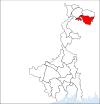 | |
| DA | Darjeeling | Darjeeling | 1947 | 2,092.5 km2 (807.9 sq mi) | 1,797,422 | 859/km2 (2,220/sq mi) | 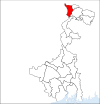 | |
| ME | Purba Medinipur | Tamluk | 2002[18] | 4,736 km2 (1,829 sq mi) | 5,094,238 | 1,076/km2 (2,790/sq mi) |  | |
| HG | Hooghly | Chinsura | 1947 | 3,149 km2 (1,216 sq mi) | 5,520,389 | 1,753/km2 (4,540/sq mi) |  | |
| HR | Howrah | Howrah | 1947 | 1,467 km2 (566 sq mi) | 1,072,161 | - |  | |
| JP | Jalpaiguri | Jalpaiguri | 1869 | 2,844 km2 (1,098 sq mi) | 2,172,846 | 621/km2 (1,610/sq mi) | 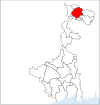 | |
| JH | Jhargram | Jhargram | 2017[4] | 3,037.64 km2 (1,172.84 sq mi) | 1,136,548 | 833/km2 (2,160/sq mi) | ||
| KO | Kolkata | Kolkata | 1947 | — | 185 km2 (71 sq mi) | 4,486,679 | 24,252/km2 (62,810/sq mi) |  |
| KA | Kalimpong | Kalimpong | 2017[18] | 1,044 km2 (403 sq mi) | 251,642 | |||
| MA | Malda | English Bazar | 1947 | 3,733 km2 (1,441 sq mi) | 3,997,970 | 1,071/km2 (2,770/sq mi) |  | |
| MU | Murshidabad | Baharampur | 1947 | 5,324 km2 (2,056 sq mi) | 7,102,430 | 1,334/km2 (3,460/sq mi) |  | |
| NA | Nadia | Krishnanagar | 1947 | 3,927 km2 (1,516 sq mi) | 5,168,488 | 1,316/km2 (3,410/sq mi) |  | |
| PN | North 24 Parganas | Barasat | 1986[15] | 4,094 km2 (1,581 sq mi) | 10,082,852 | 2,463/km2 (6,380/sq mi) | 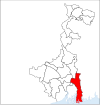 | |
| UD | Uttar Dinajpur | Raiganj | 1992[16] | 3,140 km2 (1,210 sq mi) | 3,000,849 | 956/km2 (2,480/sq mi) |  | |
| PU | Purulia | Purulia | 1956[6] | 6,259 km2 (2,417 sq mi) | 2,927,965 | 468/km2 (1,210/sq mi) | 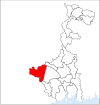 | |
| PS | South 24 Parganas | Alipore | 1986[15] | 9,960 km2 (3,850 sq mi) | 8,153,176 | 819/km2 (2,120/sq mi) | 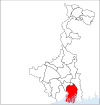 | |
| DD | Dakshin Dinajpur | Balurghat | 1992[17] | 2,219 km2 (857 sq mi) | 1,670,931 | 753/km2 (1,950/sq mi) |  | |
| ME | Paschim Midnapore | Medinipur | 2002[18] | 9,345 km2 (3,608 sq mi) | 5,943,300 | 636/km2 (1,650/sq mi) |  | |
| Total | 22 | — | — | 72 | 88,752 km2 (34,267 sq mi) | 91,347,736 | 1,029/km2 (2,670/sq mi) | 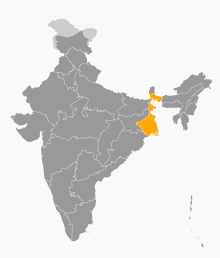 |
Demographics
The following is a list of the basic demographic data for the districts of West Bengal by their population rank in India[36]
| Rank | District | Population | Growth Rate | Sex Ratio | Literacy | Density/KM | Comparable Country (by population)[37] |
|---|---|---|---|---|---|---|---|
| 2 | North 24 Parganas | 11,060,148 | 12.86 | 955 | 84.53 | 2,445 | Bolivia |
| 6 | South 24 Parganas | 9,161,961 | 18.17 | 956 | 77.51 | 819 | Honduras |
| 7 | Bardhaman | 7,717,563 | 11.92 | 945 | 76.21 | 1,099 | Togo |
| 9 | Murshidabad | 7,103,807 | 21.09 | 958 | 66.59 | 1,334 | Bulgaria |
| 14 | West Midnapore | 5,943,300 | 14.44 | 960 | 79.04 | 636 | Kyrgyzstan |
| 16 | Hooghly | 5,520,389 | 9.49 | 958 | 82.55 | 1,753 | Finland |
| 18 | Nadia | 5,168,488 | 12.24 | 947 | 75.58 | 1,316 | Congo |
| 20 | East Midnapore | 5,094,238 | 15.32 | 936 | 87.66 | 1,076 | Eritrea |
| 23 | Howrah | 4,841,638 | 13.31 | 935 | 83.85 | 3,300 | Ireland |
| 35 | Kolkata | 4,496,694 | -1.67 | 908 | 86.31 | 24,306 | Mauritania |
| 58 | Malda | 3,997,970 | 21.50 | 939 | 62.71 | 1,071 | Moldova |
| 66 | Jalpaiguri | 3,869,675 | 13.77 | 954 | 73.79 | 621 | Georgia |
| 80 | Bankura | 3,596,292 | 12.64 | 954 | 70.95 | 523 | Bosnia and Herzegovina |
| 84 | Birbhum | 3,502,387 | 16.15 | 956 | 70.90 | 771 | Bosnia and Herzegovina |
| 124 | North Dinajpur | 3,000,849 | 22.90 | 936 | 60.13 | 956 | Mongolia |
| 129 | Purulia | 2,927,965 | 15.43 | 955 | 65.38 | 468 | Albania |
| 136 | Cooch Behar | 2,822,780 | 13.86 | 942 | 75.49 | 833 | Lithuania |
| 257 | Darjeeling | 1,842,034 | 14.47 | 971 | 79.92 | 585 | Guinea-Bissau |
| 295 | South Dinajpur | 1,670,931 | 11.16 | 954 | 73.86 | 753 | Bahrain |
See also
References
- ^ a b c d David Christiana (1 September 2007). "Arsenic Mitigation in West Bengal, India: New Hope for Millions" (PDF). Southwest Hydrology. p. 32. Retrieved 20 December 2008.
- ^ a b Harun-or-Rashid (2012). "Partition of Bengal, 1947". In Islam, Sirajul; Jamal, Ahmed A. (eds.). Banglapedia: National Encyclopedia of Bangladesh (Second ed.). Asiatic Society of Bangladesh.
- ^ a b Chatterji, Joya (2007). The Spoils of Partition: Bengal and India, 1947–1967. Cambridge University Press. p. 58. ISBN 0-521-87536-6. Retrieved 8 December 2008.
- ^ a b c d "Brief History of Cooch Behar". Official website of Cooch Behar District. Retrieved 10 September 2008.
- ^ a b "States of India since 1947". World Statesmen website. Archived from the original on 18 June 2008. Retrieved 7 November 2008.
- ^ a b c "District profile". Official website of Purulia District. Archived from the original on 9 December 2009. Retrieved 18 November 2008.
- ^ "Archived copy". Archived from the original on 14 July 2014. Retrieved 21 June 2014.
{{cite web}}: Unknown parameter|deadurl=ignored (|url-status=suggested) (help)CS1 maint: archived copy as title (link) - ^ http://timesofindia.indiatimes.com/city/kolkata/Alipurduar-a-new-district-on-June-25/articleshow/36916065.cms
- ^ a b c "Directory of District, Sub division, Panchayat Samiti/ Block and Gram Panchayats in West Bengal, March 2008". West Bengal. National Informatics Centre, India. 19 March 2008. Archived from the original on 25 February 2009. Retrieved 19 November 2008.
{{cite web}}: Unknown parameter|deadurl=ignored (|url-status=suggested) (help) - ^ a b "Section 9 of West Bengal Panchayat Act, 1973". Department of Panchayat and Rural Department, West Bengal. Archived from the original on 10 April 2009. Retrieved 9 December 2008.
{{cite web}}: Unknown parameter|deadurl=ignored (|url-status=suggested) (help) - ^ a b "Section 94 of West Bengal Panchayat Act, 1973". Department of Panchayat and Rural Department, West Bengal. Archived from the original on 10 April 2009. Retrieved 9 December 2008.
{{cite web}}: Unknown parameter|deadurl=ignored (|url-status=suggested) (help) - ^ a b "Section 140 of West Bengal Panchayat Act, 1973". Department of Panchayat and Rural Department, West Bengal. Archived from the original on 10 April 2009. Retrieved 9 December 2008.
{{cite web}}: Unknown parameter|deadurl=ignored (|url-status=suggested) (help) - ^ Evgeny Vinokurov (2005). "Theory of Enclaves, Chapter 6: Enclave stories and case studies" (PDF). Evgeny Vinokurov's website. p. 17. Archived from the original (PDF) on 27 July 2007. Retrieved 20 December 2008.
- ^ A.G. Noorani (31 August 2001). "Of Indo-Bangladesh distrust". Frontline magazine. Archived from the original on 26 March 2009. Retrieved 29 December 2008.
{{cite web}}: Unknown parameter|deadurl=ignored (|url-status=suggested) (help) - ^ a b c Mandal, Asim Kumar (2003). The Sundarbans of India: A Development Analysis. Indus Publishing. pp. 168–169. ISBN 81-7387-143-4. Retrieved 4 September 2008.
- ^ a b "Home page". Official website of Uttar Dinajpur District. Retrieved 1 September 2008.
- ^ a b "Historical Perspective". Official website of South Dinajpur District. Retrieved 1 September 2008.
- ^ a b c d e Jana, Naresh (31 December 2001). "Tamluk readies for giant's partition". The Telegraph (Kolkata). Retrieved 1 September 2008.
- ^ "Call for Gorkhaland renewed". Darjeeling Times. 7 October 2007. Retrieved 11 December 2008.
- ^ Indo Asian News Service (25 June 2008). "West Bengal faces another blockade, this time for Kamtapur state". AOL India News. Archived from the original on 29 March 2009. Retrieved 11 December 2008.
{{cite web}}: Unknown parameter|deadurl=ignored (|url-status=suggested) (help) - ^ a b c "Section 2 of West Bengal Panchayat Act, 1973". Department of Panchayat and Rural Department, West Bengal. Retrieved 9 December 2008.[permanent dead link]
- ^ Ramesh Kumar Arora, Ramesh Kumar Arora Rajni Goyal. Indian Public Administration: Institutions and Issues. New Age Publishers. p. 298. ISBN 81-7328-068-1. Retrieved 9 December 2008.
- ^ "Section 98 of West Bengal Panchayat Act, 1973". Department of Panchayat and Rural Department, West Bengal. Archived from the original on 10 April 2009. Retrieved 9 December 2008.
{{cite web}}: Unknown parameter|deadurl=ignored (|url-status=suggested) (help) - ^ "Section 143 of West Bengal Panchayat Act, 1973". Department of Panchayat and Rural Department, West Bengal. Archived from the original on 10 April 2009. Retrieved 9 December 2008.
{{cite web}}: Unknown parameter|deadurl=ignored (|url-status=suggested) (help) - ^ "Section 185 of West Bengal Panchayat Act, 1973". Department of Panchayat and Rural Department, West Bengal. Archived from the original on 10 April 2009. Retrieved 9 December 2008.
{{cite web}}: Unknown parameter|deadurl=ignored (|url-status=suggested) (help) - ^ "Memoranda of Settlement - DGHC". Darjeeling Times. Retrieved 11 December 2008.
- ^ a b "History of Darjeeling: Darjeeling-Today". Official website of Darjeeling District. Retrieved 29 December 2008.
- ^ "The Police Act, 1861". India Code Legislative Department. Retrieved 14 December 2008.
- ^ "Indian Police Service (Uniform) Rules". Ministry of Personnel, Public Grievances and Pensions, Government of India. Archived from the original on 10 April 2009. Retrieved 14 December 2008.
{{cite web}}: Unknown parameter|deadurl=ignored (|url-status=suggested) (help) - ^ a b c "Police Organisation of India" (PDF). Commonwealth Human Rights Initiative. p. 9. Retrieved 14 December 2008.
- ^ "Different Courts in West Bengal (Other than High Courts, Kolkata)". Judicial Department, Government of West Bengal. Archived from the original on 26 March 2009. Retrieved 14 December 2008.
{{cite web}}: Unknown parameter|deadurl=ignored (|url-status=suggested) (help) - ^ "NIC Policy on format of e-mail Address: Appendix (2): Districts Abbreviations as per ISO 3166–2" (PDF). Ministry Of Communications and Information Technology, Government of India. 18 August 2004. pp. 5–10. Archived from the original (PDF) on 11 September 2008. Retrieved 24 November 2008.
{{cite web}}: Unknown parameter|dead-url=ignored (|url-status=suggested) (help) - ^ "Districts : West Bengal". Government of India portal. Retrieved 24 November 2008.
- ^ Here 'Established' means year of establishment as a district of West Bengal. The state of West Bengal was established in 1947 with 14 districts of erstwhile Bengal province of British India.
- ^ a b "Area, Population, Decennial Growth Rate and Density for 2001 and 2011 at a glance for West Bengal and the Districts" (XLS). 2011 census of India. Retrieved 13 December 2012.
- ^ "Indian Districts by Population, Growth Rate, Sex Ratio 2011 Census". Registrar General & Census Commissioner, India. Retrieved 6 April 2013.
- ^ "List of countries by population (United Nations)". Retrieved 3 April 2017.
External links
